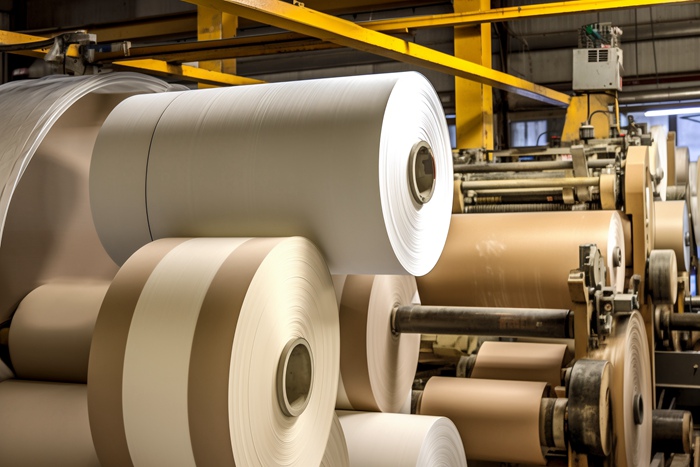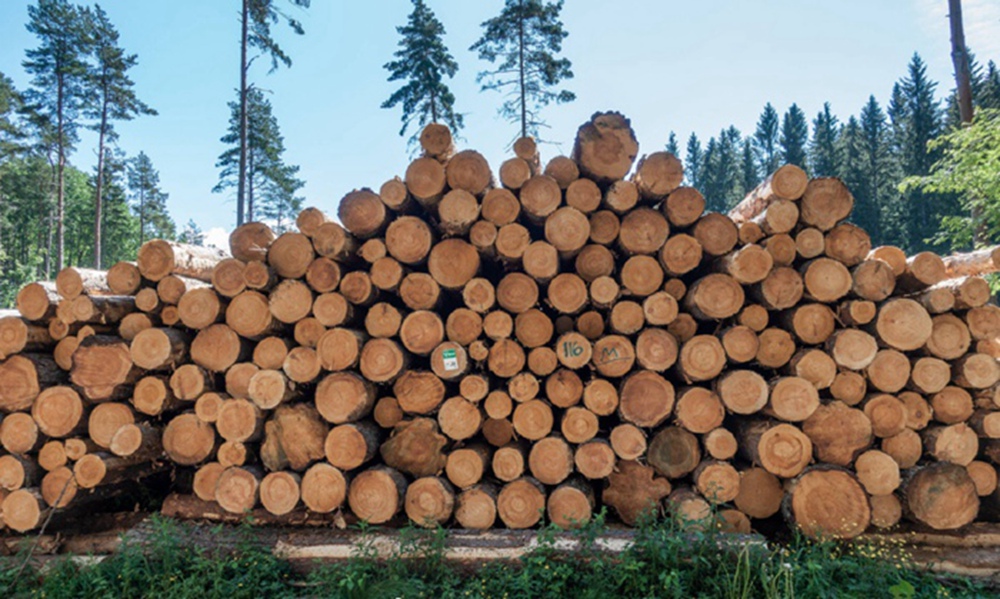Chapter 1 Papermaking process
The modern papermaking process can be divided into pulping, modulation, papermaking, coating, processing and other main steps:
Pulping section: raw material selection → cooking and fiber separation → washing → bleaching → washing and screening → concentration or papermaking → storage and standby
Molding-papermaking section: loose pulp → impurity removal → refined pulp → beating → preparation of various additives → mixing of paper materials → paper material flow → head box → net section → pressing section → drying section → surface sizing → drying → calendering → winding into paper
Coating section: coating base paper → coating machine coating → drying → winding → rewinding → super calendering
Processing section: rewinding → cutting flat plate (or roll) → sorting and packaging → storage end
1. Pulping: Pulping is the first step in papermaking. Generally, there are three methods for converting wood into pulp: mechanical pulping, chemical pulping, and semi-chemical pulping.
Papermaking raw materials: There are two major categories: plant fiber and non-plant fiber (inorganic fiber, chemical fiber, metal fiber).
Bleaching: This process will produce a large amount of black liquor, which is the source of pollution.
2. Modulation: The modulation of paper is another key point of papermaking. The strength, color tone, printing quality and shelf life of the finished paper are directly related to it. The common modulation process can be roughly divided into the following three steps: pulping, beating, adding glue and filling.
(I) Pulping: Use physical methods to treat pulp fibers suspended in water so that they have the characteristics required by papermaking machine production and produce paper and paperboard that meet quality requirements. This operation process is called beating. The effects of beating on fibers: displacement and deformation of cell walls, rupture of the outer layers of primary and secondary walls, water absorption and swelling, fine fiberization and transverse cutting, etc.
(II) Seasoning:
1. Sizing – By adding water-resistant sizing substances to the pulp, the paper has a certain water resistance and is not easily wetted by water or aqueous solutions to a certain extent. This operation process is called sizing.
2. Paper and paperboard are divided into the following types according to the degree of sizing:
Heavily sizing paper: writing paper, offset printing paper, drawing paper, wrapping paper, book cover paper, paper bag paper, etc.
Lightly sizing paper: letterpress printing paper, gravure printing paper, typing paper, glossy paper, and coated thick paper, etc.
Unsizing paper: blotting paper, cigarette paper, newsprint rolls, filter paper, toilet paper, impregnated paper base paper, modified paper, and steel paper base paper, etc.
(III) Filling: Adding minerals or artificial fillers that are insoluble or not easily soluble in water to the paper stock suspension.
III. Papermaking process: The thin paper stock is evenly interwoven and dehydrated, and then dried, calendered, rolled, cut, sorted, and packaged. Therefore, the general common process is as follows:
1. Screening of paper stock: Dilute the prepared pulp to a lower concentration, and use the screening equipment to screen out debris and undissociated fiber bundles again to maintain quality and protect equipment.
2. Net section: Make the paper material flow out from the head box and evenly distribute and interweave on the circulating copper wire mesh or plastic mesh.
3. Pressing section: Lead the wet paper removed from the net surface to two rollers with a felt cloth attached. Through the squeezing of the rollers and the water absorption of the felt cloth, the wet paper is further dehydrated and the paper is made tighter to improve the paper surface and increase the strength.
4. Drying: Since the moisture content of the wet paper after pressing is still as high as 52-70%, it is no longer possible to use mechanical force to press out the moisture at this time, so the wet paper is allowed to pass through many cylinders with hot steam inside to dry the paper.
5. Surface sizing – also called paper surface sizing. It is to immerse the paper or paperboard into the sizing agent solution or apply a thin layer of sizing agent to the paper surface with a sizing machine. After the sizing agent dries, a liquid-resistant film is formed on the paper surface, making the paper water-resistant. It can also increase the strength and stiffness of the paper, improve the writing performance of the paper, improve the friction resistance and durability of the paper, and solve the problems of paper shedding and powdering. It is mostly used for high-quality paper types, such as banknote paper, bond paper, playing card paper, high-grade writing paper, high-grade offset printing paper, etc.
6. Calendering: The calender is used to improve the smoothness, glossiness and thickness uniformity of the paper.
7. Paper roll: The paper out of the calender is rolled into a roll online.
4. Coating: A layer of coating (coating color) is applied to the base paper to give the paper good optical properties and printing performance. Its main uses are: publishing paper such as printing magazines and books and printing paper such as trademarks, packaging, and product catalogs. The ratio of the two is about 1:3. Coated paper can be roughly divided into: coated paper, coated paper, lightweight coated paper, in addition to special coated paper such as burnished coated paper. The manufacture of coated paper simply means coating the base paper with coating, and then using a calender to smooth its surface after drying. Therefore, the base paper and coating are important factors affecting the quality of coated paper.
5. Processing: cutting, sorting, and packaging: Take multiple rolls of paper that have been rolled into a tube, cut them into sheets with a paper cutter, and then sort them manually or mechanically to remove damaged or stained paper. Finally, pack every 500 sheets into a package (usually called a ream).


